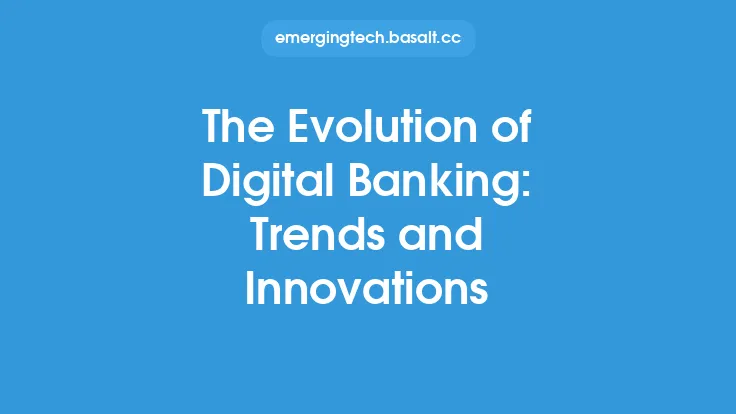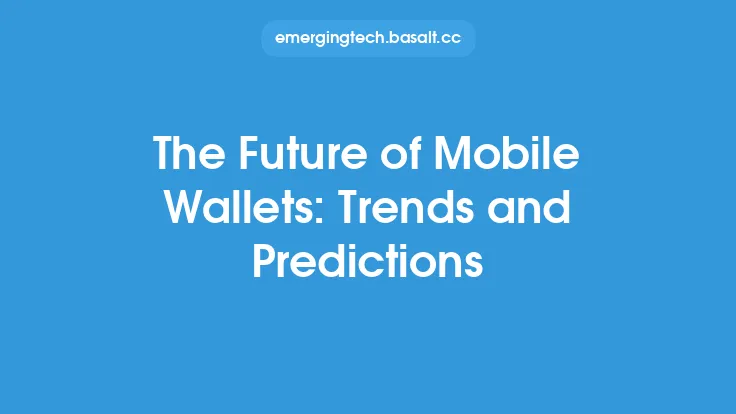The world of digital payments is on the cusp of a revolution, driven by emerging technologies and innovations that are transforming the way we make transactions. As the fintech industry continues to evolve, new technologies such as artificial intelligence, blockchain, and the Internet of Things (IoT) are being leveraged to create faster, more secure, and more convenient payment systems. In this article, we will explore the future of digital payments, highlighting the key technologies and innovations that are shaping the industry.
Introduction to Emerging Technologies
Emerging technologies such as artificial intelligence (AI), machine learning (ML), and deep learning (DL) are being used to improve the speed, security, and efficiency of digital payments. AI-powered payment systems can analyze vast amounts of data to detect and prevent fraudulent transactions, while ML algorithms can learn from patterns in payment data to improve the accuracy of transaction processing. DL techniques, on the other hand, can be used to develop more sophisticated payment authentication systems, such as voice and facial recognition.
The Role of Blockchain in Digital Payments
While blockchain technology is often associated with cryptocurrencies such as Bitcoin, its potential applications in digital payments extend far beyond digital currencies. Blockchain-based payment systems can provide a secure, decentralized, and transparent way to make transactions, reducing the need for intermediaries and increasing the speed of payment processing. Additionally, blockchain technology can be used to create smart contracts, which can automate payment processes and reduce the risk of disputes.
The Internet of Things (IoT) and Digital Payments
The IoT refers to the network of physical devices, vehicles, and other items that are embedded with sensors, software, and connectivity, allowing them to collect and exchange data. In the context of digital payments, the IoT can enable new forms of payment, such as contactless payments and wearable payments. For example, smartwatches and fitness trackers can be used to make payments, while smart home devices can be used to authorize transactions.
Biometric Authentication and Digital Payments
Biometric authentication refers to the use of unique physical characteristics, such as fingerprints, facial recognition, and voice recognition, to verify identities and authorize transactions. Biometric authentication can provide a more secure and convenient way to make payments, reducing the need for passwords and PINs. Additionally, biometric authentication can be used to prevent fraudulent transactions, as it is more difficult for hackers to replicate biometric characteristics.
Quantum Computing and Digital Payments
Quantum computing refers to the use of quantum-mechanical phenomena, such as superposition and entanglement, to perform calculations that are beyond the capabilities of classical computers. In the context of digital payments, quantum computing can be used to break certain types of encryption, potentially compromising the security of payment systems. However, quantum computing can also be used to develop new forms of encryption, such as quantum key distribution, which can provide a more secure way to protect payment data.
5G Networks and Digital Payments
The rollout of 5G networks is expected to have a significant impact on digital payments, enabling faster and more reliable payment processing. 5G networks can provide speeds of up to 20 Gbps, reducing the latency and increasing the throughput of payment transactions. Additionally, 5G networks can enable new forms of payment, such as augmented reality (AR) payments and virtual reality (VR) payments.
Open Banking and Digital Payments
Open banking refers to the practice of sharing financial data between institutions, enabling new forms of payment and financial services. Open banking can provide a more secure and convenient way to make payments, as it allows users to authorize transactions directly from their bank accounts. Additionally, open banking can enable new forms of payment, such as account-to-account payments and request-to-pay payments.
Digital Payments and the Cloud
Cloud computing refers to the practice of storing and processing data remotely, over the internet. In the context of digital payments, cloud computing can provide a more secure and scalable way to process transactions, reducing the need for on-premise infrastructure. Additionally, cloud computing can enable new forms of payment, such as cloud-based wallets and cloud-based payment gateways.
The Future of Digital Payments
The future of digital payments is likely to be shaped by emerging technologies such as AI, blockchain, and the IoT. As these technologies continue to evolve, we can expect to see new forms of payment, such as contactless payments, wearable payments, and biometric payments. Additionally, the use of quantum computing, 5G networks, and open banking is likely to increase, enabling faster, more secure, and more convenient payment systems. As the fintech industry continues to innovate, it is likely that digital payments will become even more ubiquitous, convenient, and secure, transforming the way we make transactions forever.





